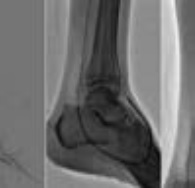Percutaneous Transluminal Angioplasty of Critical Limb Ischemia
DOI:
https://doi.org/10.53903/01212095.86Keywords:
Angioplasty, Peripheral arterial disease, Popliteal arteryAbstract
Objective: To evaluate and describe the clinical results of percutaneous transluminal angioplasty of critical limb ischemia in a level IV care center. Materials and methods: Observational analytical ambispective cohort study. Results: An infra-popliteal angioplasty was performed in the Radiology service of FOSCAL and FOSCAL International between the months of September 2013 and April 2016 to 65 patients. Prior to the procedure, 89% of the patients presented claudicati coldness of the limb, 81% of the patients presented ulceration and 64% infection, noting that 63% of the population had 3 associated symptoms. The patients were divided into two groups; the first, those who had undergone angioplasty in a single vessel and the esecond group who had undergone angioplasty in two or more vessels. We found that the amputation-free time was greater in the group one compared to group two, with a statistically significant P value. Conclusion: Angioplasty of infrapopliteal vessels in patients with peripheral arterial disease (PAD) and critical lower limb ischemia reduces pain, claudication and infection in patients. There is a low rate of major amputations after therapy as a measure of salvage of the limb. The probability of survival of the limb at 573 days is 50%.on and pain, 88%
Downloads
References
Diehm C, Lange S, Darius H et al. Association of low ancle brachial index with high mortality in primary care. Europ Heart J. 2006;27:1743-9.
Rastogi MS, Stavropoulos W. Infrapopliteal angioplasty. Tech Vasc Interv Radiol. 2004;7(1):33-9.
Nawalany M. Endovascular therapy for limb salvage. Surg Clin N Am. 2010;90:1215- 25.
Dattilo PB, Casserly IP. Critical limb ischemia: Endovascular strategies for limb salvage. Prog Cardiovasc Dis. 2011;54(1):47-60.
Khan MU, Lall P, Harris LM, Dryjski ML, Dosluoglu HH. Predictors of limb loss despite a patent endovascular-treated arterial segment. J Vasc Surg. 2009;49:1440-6.
Gallagher KA, Meltzer AJ, Ravin RA, Graham A, Shrikhande G, Connolly PH, et al. Endovascular management as first therapy for chronic total occlusion of the lower extremity arteries: Comparison of balloon angioplasty, stenting, and directional atherectomy. J Endovasc Ther. 2011;18:624-37.
Hardman RL, Jazaeri O, Yi J, Smith M, Gupta R. Overview of classification systems in peripheral artery disease. Semin Intervent Radiol. 2014;31(4):378-88.
Armstrong DG, Lavery LA, Harkless LB. Validation of a diabetic wound classification system. The contribution of depth, infection, and ischemia to risk of amputation. Diabetes Care. 1998;21(5):855-9.
Hirsch AT, Haskal ZJ, Hertzer NR et al. ACC/AHA 2005 Practice Guidelines for the management of patients with peripheral arterial disease (lower extremity, renal, mesenteric, and abdominal aortic). Circulación. 2006;13(11):e463-654.
Internacional Diabetes Federation. Diabetes Atlas 8th Edition. http://www.diabetesatlas.org.
Abdelsalam H, Markose G, Bolia A. Revascularization strategies in below the knee interventions. J Cardiovasc Surg (Torino). 2008;49:187-91.
Zeller T, Sixt S, Rastan A. New Techniques for endovascular treatment of peripheral artery disease with focus on chronic critical limb ischemia. Vasa. 2009;38:3-12.
Agarwal S, Sud K, Shishehbor MH. Nationwide trends of hospital admission and outcomes among critical limb ischemia patients: From 2003-2011. J Am Coll Cardiol. 2016;67:1901-13.
Conte MS, Geraghty PJ, Bradbury AW, Hevelone ND, Lipsitz SR, Moneta GL, Nehler MR, Powell RJ, Sidawy AN. Suggested objective performance goals and clinical trial design for evaluating catheter-based treatment of critical limb ischemia. J Vasc Surg. 2009;50:1462-73
Yan BP, Moran D, Hynes BG, Kiernan TJ, Yu CM. Advances in endovascular treatment of critical limb ischemia. Circ J. 2011;75:756-65.
Spreen MI, Martens JM, Hansen BE, Knippenberg B, Verhey E, van Dijk LC. Percutaneous transluminal angioplasty and drug-eluting stents for infrapopliteal lesions in critical limb ischemia (PADI) Trial. Circ Cardiovasc Interv. 2016;9(2):e002376.
Klevsgard R, Risberg BO, Thomsen MB, Hallberg IR. A 1-year follow-up quality of life study after hemodynamically successful or unsuccessful surgical revascularization of lower limb ischemia. J Vasc Surg. 2001;33:114-22.
Conte MS. Understanding objective performance goals for critical limb ischemia trials. Semin Vasc Surg. 2010;23:129-37.
Haimovici H. Patterns of arteriosclerotic lesions of the lower extremity. Arch Surg. 1967;95:918-33.
Fraser SCA, Al-Kutoubi MA, Wolfe JHN. Percutaneous transluminal angioplasty of the infrapopliteal vessels: the evidence. Radiology. 1996;200:33-43

Downloads
Published
How to Cite
Issue
Section
License

This work is licensed under a Creative Commons Attribution-NonCommercial-ShareAlike 4.0 International License.
La Revista Colombiana de Radiología es de acceso abierto y todos sus artículos se encuentran libre y completamente disponibles en línea para todo público sin costo alguno.
Los derechos patrimoniales de autor de los textos y de las imágenes del artículo como han sido transferidos pertenecen a la Asociación Colombiana de Radiología (ACR). Por tanto para su reproducción es necesario solicitar permisos y se debe hacer referencia al artículo de la Revista Colombiana de Radiología en las presentaciones o artículos nuevos donde se incluyan.







